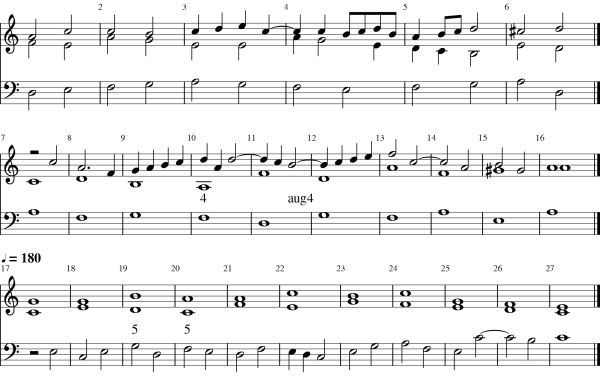Audio: multipart counterpoint (0:47)

multipart counterpoint sings fifth species modal counterpoint in three parts. The multipart counterpoint figure shows the score consists of three sections:
Multipart counterpoint comes in two flavours, modal and tonal. Counterpoint in two parts is modal counterpoint. Three part modal counterpoint, the focus of this chapter, continues in the same vein. Tonal counterpoint uses major and minor scales not modes, is chordal in nature, and is covered in the section on functional harmony.
The plethora of rules and exceptions for writing three part modal counterpoint are summarised below:
The bass part is used as the reference part for the utterly prosaic reason is that it is easier to construct and check intervals upwards than it is downwards (try it).
A piece starts and ends on the tonic in the bass part, with the upper parts forming an interval of a third and a fifth. A piece ends the same way or with a doubled tonic or doubled third or tripled tonic. Minor mode endings are more complicated because a minor third does not signal closure. Instead, the aeolian and dorian modes end with a doubled tonic plus fifth or with a tripled tonic. The troublesome phrygian mode ends this way too or with a doubled tonic plus major third.
Any note can be doubled, preferably at the octave rather than unison. The choice of which note to double largely depends on how it will impact the melody in the affected part. By convention, the leading note in the scale, the seventh degree, is never doubled.
The rules for contrapuntal consonance are relaxed in three part modal counterpoint. They have to be. The main consequence is that the fourth is partially rehabilitated as a consonant interval. There is only one way to use it, which is to hide it in the upper parts where its dissonant effect is perceived to less obvious than if it was between the bass and one of the upper parts. Furthermore, the dreaded tritone occasionally occurs to preserve melodic motion, and it too must be written between the two upper parts.
The rules for contrapuntal motion also have to change. The reason is that relative motion does not work in three parts. While two parts can move in relative motion, three parts cannot. The pitch of a melody can only go up or down not sideways into a third dimension. The immediate consequence is that there will be much more oblique and direct motion in three parts.
A parallel fifth is as difficult to avoid in three parts as it in is two. The solutions are to rearrange the upper parts, use parallel thirds and parallel sixths, and to double a note. There must always be at least one interval of a third or sixth in three part modal counterpoint, which means no tripled notes, except at the end.
Fast forward from three to four part modal counterpoint. The good news is there are still only three different notes, the same as in three part modal counterpoint, because one of the existing notes is doubled to make four part harmony. The bad news is lots more checks, 25, for each group of notes. It is a wonder any music ever gets written, looks more like an exercise in masochism. But please feel free to give it a try.